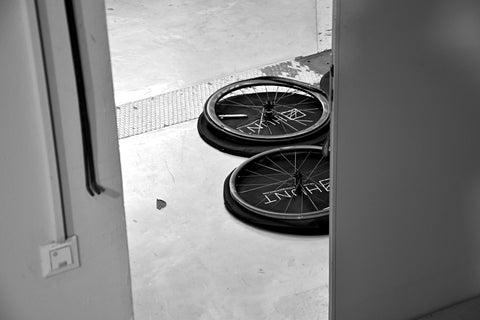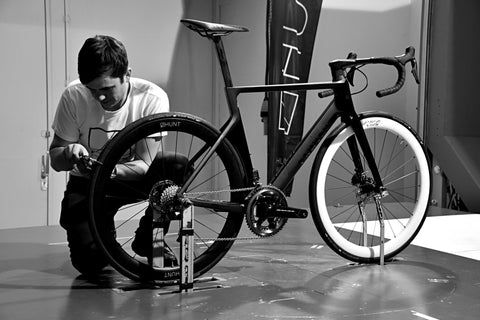#REDEFINEWIDE AERO TESTING EXPLAINED: WHEEL ENGINEER LUISA GRAPPONE WEIGHS IN ON RESULTS

Aerodynamics has long been something considered inaccessible to many riders. We want to change that. Up until now, only very few have released results yielded from wind tunnel testing. After travelling back from the GST Gesellschaft für Strömungsmeßtechnik mbH (more commonly known as the Airbus Wind Tunnel as used by Canyon) in Southern Germany, Luisa has since reviewed the results marking the next step forward. Now she explains exactly what happens.
For this very special On The Drops, we catch Luisa and ask her questions that most riders (without prior engineering/fluid dynamics knowledge) would ask her. Over the course of this development process, we will be checking in with Luisa and seeing how things are progressing.

-
What was the primary reason for doing the wind tunnel tests?
The aim was to design an aero wheel which can match the benefits of 28mm tyres, tubeless technology and disc brakes. We had already in mind some shape configurations and I knew already how important could be the area where the spoke nipples are, so in order to find the best aero shape and freeze the design we decided to perform wind tunnel tests. Wind tunnel is in fact the most accurate option for measuring the drag of an object, producing precise data acquisition and providing consistent and reliable results. Of course it doesn’t perfectly replicate the real world but it is the best tool to help us make decisions about how to design a wheel that will work be fastest in a wide variety of real world conditions.
Coming out of the test, were there any surprises in the results?
The wind tunnel confirmed the design we had in mind. Going for a very wide rim works, but you need to get the right shape on the nipple side too Iexpected good results in terms of aerodynamics but when I saw the data of our prototypes were comparable and in some conditions even better than our main competitors, I have to say I was very happy and proud of what we had achieved.

We tested a few 3D print rim models. What is the difference between the prototype rim profiles?
As mentioned above, we had in mind some different shape configurations and an idea of how wide and deep we wanted the rim to be so I started to work on getting some different rim profiles which could better interconnect the upper and lower parts of the rim.
I started with some conventional rims, not so wide, not so big and bulgy, and from there I looked at how wide the rim and how big the area where the nipples are could be.
I ended up with 5 different designs combining these different design elements.
Why did we use an ENVE wheel for the rear? Surely a Hunt 50Carbon Aero Disc would have made more sense...
When you do a wind tunnel test what really matters is the front part of the bike so keeping the same rear wheel lets you test many more combinations with only one day in the tunnel. To keep things consistent we chose to use one of the best aero wheels on the market, considering the medium depth rim range, the Enve 4.5, as our reference rear wheel.

Is there anything super unique about any of 3D printed prototypes or do all five still resemble a somewhat traditional shape?
There were five prototypes: Two of them reflecting quite a conventional shape. But for 3 of them we wanted to dare and decided to go quite wide and big.

With this information, what is the next step in the wheel development process? Are there any more plans to head back to the wind tunnel?
As already mention to road.cc (article here), success with the prototype is good news but it’s only the beginning of the process of getting a new wheel. We are going to the wind tunnel soon again for getting more measurements. We have already in mind to apply some changes to our best prototype and see whether these changes can improve even further the aerodynamics of the wheel. And we will surely test a wheelset next not just front wheel.
What are the main priorities when designing a wheel around a tyre? Should we look at the two as a system which work together or can they be individualized to be aerodynamic in their own right?
The tyre choice plays a key role. The tyre pattern, the width and shape in fact have a great impact on aerodynamic drag and even using two different tyres of the same brand model can change the wind tunnel test results when differences in rim shape are small.
This is way during the design phase, our focus was not just on the rim shape but also on the global system of the tyre plus rim. We designed our prototype considering a particular tyre model and our aim was to obtain the best aero rim shape around that particular tyre.

With so much wind tunnel testing done by all the bike bicycle and wheel manufactures, is there huge differences between all of the big contenders? What sets them apart?
With the trend of wider and “bulgy” rims, there is a very small difference between the main contenders. Sometimes we talk about few grams force of difference between one wheel and the other. Surely all the wind tunnel tests performed in the past years by all
the wheels manufactures have confirmed that the V-Shaped rims don’t work.
Are there any things which will make a wheel more aerodynamic but does not translate across into real world use well (like internal nipples)?
A smaller tyre, for example a 25mm tyre if compared to a 28mm tyre is more aerodynamic when tested in the wind tunnel. But cyclists are appreciating more of the benefits of a wider tyre. A rim brake wheel is generally speaking more aero than a disc brake one because of the disc rotor on the non-drive side of the bike. This affects the overall aerodynamics, but once again we know the pros of using a disc brake wheelset over a rim brake one.

Thanks Luisa!



